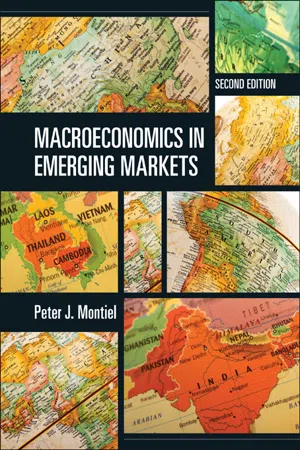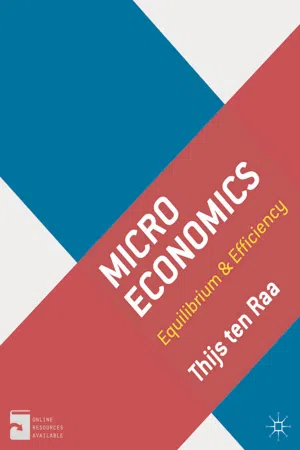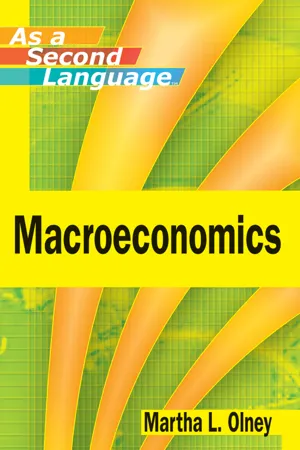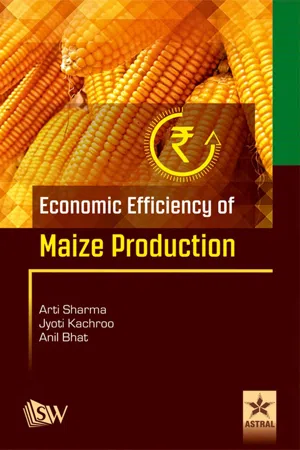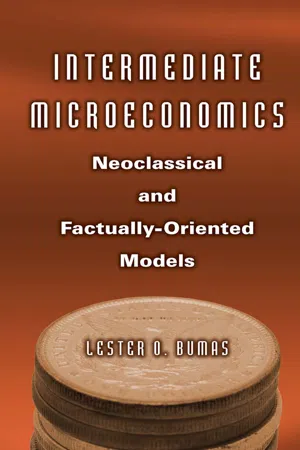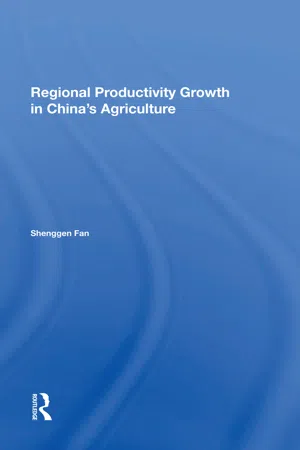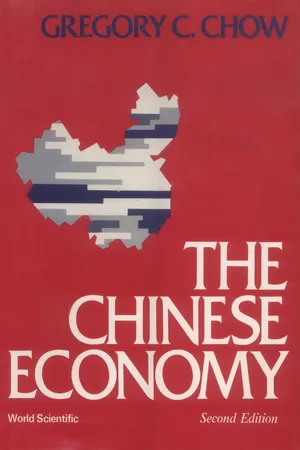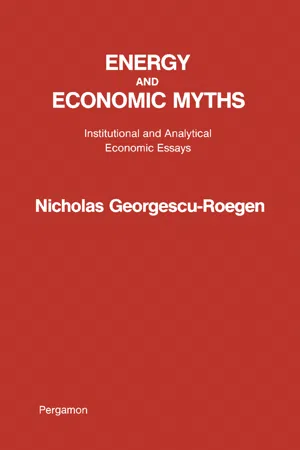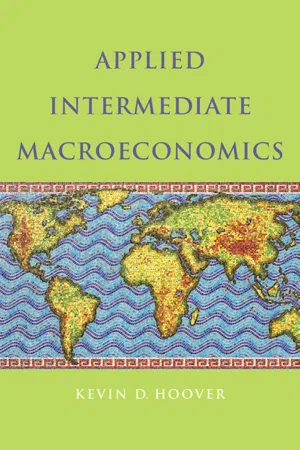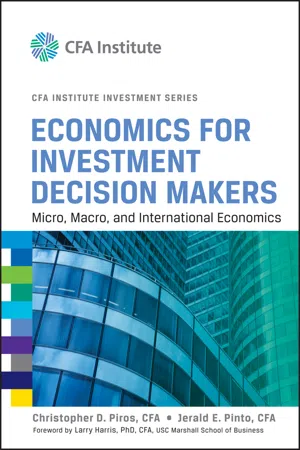Economics
Aggregate Production Function
The aggregate production function represents the relationship between the total output of an economy and the inputs used in production, such as labor and capital. It is a key concept in macroeconomics and is used to analyze the overall productivity and efficiency of an economy. The aggregate production function helps economists understand the factors that contribute to economic growth and development.
Written by Perlego with AI-assistance
Related key terms
1 of 5
12 Key excerpts on "Aggregate Production Function"
- eBook - PDF
- Peter J. Montiel(Author)
- 2011(Publication Date)
- Cambridge University Press(Publisher)
In the real world, Y would represent a country’s real gross domestic product (GDP). 1 We can think of this single good as a composite, possibly consisting of many individual goods. Our assumption of complete specialization just means that we will not be analyzing changes in relative prices among goods produced domestically. The Aggregate Production Function, the Labor Market, and Aggregate Supply 79 The Aggregate Production Function is a relationship that summarizes how the feasible level of aggregate output in an economy is influenced by the amounts used of whatever inputs are used for production in that economy as well as by the productivity of such inputs. To produce the good, we will suppose that firms in the economy employ the services of physical capital and labor. We can therefore write the Aggregate Production Function in the form Y = (4.1) AF ( K , L ), + + where A is a parameter that serves as an index of the total productivity of the resources employed, K is the stock of physical capital, and L denotes the level of employment. 2 The positive signs under K and L signify that independent increases in each of these variables (i.e., an increase in one, holding the other constant) increase the level of output. Notice that we can write A as A = Y / F ( K, L ), so A is the average productivity of a combination of physical capital and labor. An increase in A means that the economy becomes more productive, in the sense that more output can be produced with the same combination of physical capital and labor. Because changes in A correspond to changes in the productivity of a combination of both factors of production, A is usually referred to as an indicator of total factor productivity (TFP), which was introduced in the preceding chapter. 3 1. Properties of the Aggregate Production Function To use this production function, we will need to say something about its properties. - eBook - PDF
Microeconomics
Equilibrium and Efficiency
- Thijs ten Raa(Author)
- 2017(Publication Date)
- Red Globe Press(Publisher)
R. Solow, “Technical Change and the Aggregate Production Function,” Review of Economics and Statistics 39, 3, 312–320 (1957). 121 7 Production functions 7.1 Introduction A production function helps to determine how much output can be produced with given inputs. For instance, if you have one million workers, 100,000 tools, and 100 square miles of arable land, then you can grow a certain quantity of rice. This is not to say that these inputs are actually available. The popula-tion figure may be too low, or the workers may not be willing to supply their labor services in full if wages are too low (or too high – so that they can earn enough working part time). Thus the production function is an important tool that economists use to understand the supply of goods and services in an economy and, ultimately, the standard of living. Some economies have strong production functions that yield a lot of output per input, while others have weaker produc-tion functions. It is not always obvious why such differences exist. After all, if a third-world country had the same inputs as a developed country – land, fertiliz-ers, knowledge, and skills – then it should be able to produce the same quantity of output. Many economists argue that this is the case, since production functions are the same across countries; but we disagree. Why do production functions vary? First it is important to remember that, as a rule, models are incomplete. There are always unaccounted inputs, such as cli-mate conditions – for example, in an arid country fewer crops (output) will be harvested with the same labor, capital, and produced inputs as in a temperate country. Second, and more subtly, some countries are more successful than oth-ers in extracting the maximum possible output from given inputs. For instance, their labor may be more used to discipline, their products more reliable (this is especially important when they are used as inputs), and so on. - eBook - PDF
- Martha L. Olney(Author)
- 2011(Publication Date)
- Wiley(Publisher)
What is the Aggregate Production Function for output? 6. What is—and isn’t—included in “capital”? Diminishing Marginal Returns One important concept from microeconomics shows up here: the law of diminishing marginal returns. As the quantity of one input increases while holding constant the quantity of the other inputs, there is more output produced. But! But each time we increase the quantity of that one input, the increases in output get smaller and smaller. This law of diminishing marginal returns impacts the shape of the Aggregate Production Function. As always, the graph is in just two dimensions. (You will never see a three-dimensional graph in introductory economics!) The quantity of output goes on the vertical axis. The quantity of one input—let’s choose labor—goes on the horizontal axis. The curve in Figure 5.1 looks at how the quantity of output changes as we change the quantity of one input holding constant the quantities of the other inputs and the amount of knowledge . A graph that shows how output per worker depends on the capital-labor ratio—holding constant the natural resources-to-labor ratio and the amount of knowledge —would have the same shape. A constant increase in the capital-labor ratio would yield ever smaller increases in output per worker. Aggregate Production Function 77 Total output Quantity of labor Aggregate Production Function Bigger output Smaller output Different output Same size L L L L L Figure 5.1 Aggregate Production Function. The graph of the Aggregate Production Function shows how the quantity of output varies with changes in one of the inputs, holding constant the quantities of the other inputs and the amount of knowledge. The curve is upward-sloping, because more labor produces more output. The curve gets flatter and flatter because of the law of diminishing returns: the increases in output get smaller and smaller as more and more labor is used. - eBook - PDF
- Sharma, Arti(Authors)
- 2021(Publication Date)
- Scholars World(Publisher)
Chapter 2 Theory of Production Function and Economic Efficiency A production function relates to physical output of a production process to physical inputs or factors of production. The production function is one of the key concepts of neoclassical theories, used to define marginal product and to distinguish allocative efficiency, the defining focus of economics. The primary purpose of the production function is to address technical efficiency, resource use efficiency and allocative efficiency in the use of factor inputs in production and the resulting distribution of income to those factors, while abstracting away from the technological problems of achieving technical efficiency, Aggregate Production Functions are estimated to create a framework in which to distinguish how much of economic growth to attribute to changes in factor allocation and how much to attribute to advancing technology. 2.1 Concept of Production Functions The theory of production is mainly concerned with maximizing profit or in some instances minimizing cost. Both are indicative of economic efficiency. The profit-maximizing firm in perfect competition (taking output and input prices as given) will choose to add input right up to the point where the marginal cost of additional input matches the marginal product in additional output. This implies an ideal division of the income generated from output into an income due to each input factor of production, equal to the marginal product of each input. To satisfy the mathematical definition of a function, a production function is customarily assumed to specify the maximum output This ebook is exclusively for this university only. Cannot be resold/distributed. obtainable from a given set of inputs. The production function, therefore, describes a boundary or frontier representing the limit of output obtainable from each feasible combination of input. - eBook - PDF
- Kumar, K Nirmal Ravi(Authors)
- 2021(Publication Date)
- Daya Publishing House(Publisher)
From the above discussion, it is clear that, a production function is an expression of quantitative (physical) relation between change in inputs and the resulting change in output. So, it is expressed as Y = f(X 1 , X 2 , X 3 , —, Xn). In microeconomic analysis, conventionally, we study the following two aspects of relation between inputs and output. ‘In what manner the output changes, if only one of the inputs is varied and other inputs are kept constant ’. This falls under Short run production function explained by LDR. ‘In what manner the output changes, if all the inputs all varied simultaneously and in the same proportion’ . This This ebook is exclusively for this university only. Cannot be resold/distributed. falls under long run production function and is explained by the concept of RTS. Technical unit: It refers to a convenient unit of studying about production programme. It also refers to a single convenient unit in production for which output, costs and returns will be worked. e.g .: Cost of cultivation of paddy per hectare. Economic unit : It is also called as ‘Plant’. It refers to aggregation of all the individual units for which output, costs, returns will be worked as whole. e.g .: Cost of cultivation of paddy in a college farm say, in 17.55 hectares. Production period: It is also called as Transformation period. It is defined as the period taken by the resources and resource services to be completely transformed into final product in a production programme. For example, production period of paddy is 120 days. Farm productivity: Farm productivity implies output per unit of land. For example, productivity of paddy is 2.5 tonnes/ha. Choice indicator: Choice indicator is an yardstick or criterion indicating, which of the available alternatives will optimize or maximize the given objective or given end. That is, the farmer has to opt for one of the available alternatives in a given production programme, so as to minimize the cost or maximize the profits. - eBook - ePub
Intermediate Microeconomics
Neoclassical and Factually-oriented Models
- Lester O. Bumas(Author)
- 2015(Publication Date)
- Routledge(Publisher)
CHAPTER FIVEThe Production Function, Productivity, and Productivity GrowthThe production function relates the rate of production to the state of technology and the employment of the factors of production. It is arguably the most important function in the neoclassical paradigm because: (1) It is the basis of the cost functions. (2) Its slope, the marginal productivity function, is the foundation of the factor demand functions. (3) And with factor supplies given, marginal productivity functions yield the distribution of income to the factors of production.In a general sense, the production function represents very practical and well-known relationships implicit in all employment change decisions made by managers to vary the rate of production.The analysis used in the area of production closely parallels that used in the basic neoclassical models of consumer behavior. Marginal productivity analysis, to be used here, is very much like marginal utility analysis previously covered. The same is true of the close relationship between the isoquant analysis of this chapter and the previously presented indifference curve analysis.Finally, an increasing standard of living, a common aspiration in acquisitive societies, essentially requires advances in technology and productivity, which shifts the production function.The Production Function
The production function is defined as follows:The production function relates the maximum rate of production possible, Q , to the employment of the factors of production—labor, L , and capital, K —at a given level of technology, T : Q = f(T; L,K) .Why the omission of the third factor of production, land or natural resources? The answer rests on David Ricardo’s definition of land as “the original and indestructible powers of the soil.” Once a unit of land is worked on by labor or capital, it is no longer in its original or natural state. This transforms land into capital, the produced means of production. There is, however, no law against breaking capital down into categories, one or more of which could be land or closely related to land. Thus, a not uncommon form of the production function has the rate of production as a function of the employment of labor, L ; capital in the form of facilities and equipments, K ; and materials purchased from other producers, M : Q =f(T; L,K,M) . The omission of the level of technology, T - Shenggen Fan(Author)
- 2019(Publication Date)
- CRC Press(Publisher)
CHAPTER 3 ESTIMATION OF AGRICULTURAL PRODUCTION FUNCTIONS: A FRONTIER PRODUCTION FUNCTION APPROACH 3.1 Introduction The relation between inputs and outputs is one reflection of the technology used in an economy. Estimating the production function provides such a relation. By estimating production functions for different periods and regions, the effects of technical change over time and the variations stemming from the adoption of technology can be observed. A major purpose of this study is the comparison of partial and total factor productivities over time and among regions. Several approaches have been developed to measure total factor productivity, for example, the index number and production function approaches. The estimation of the production function has various purposes: to provide production elasticities, which are used as weights for the index number approach, and informatfon that is essential for the production function approach. In accounting for different sources of growth over time and sources of differences among regions in total and partial 33 34 approximation formulas are derived from productivities, the production elasticities and equilibrium can chapter chapters. mainly function. By comparing production factor cost shares, the degree of be determined also. Therefore, this provides information for succeeding To start, average production function and frontier production function are identified and then the frontier production function is specified. Several production function forms are discussed before selecting the form that is the most appropriate and statistically feasible. Data and variables are explained before the main results of estimates are discussed. Finally, the results obtained here are compared with those of previous works. 3.2 Average Production Function vs. Frontier Production Function The agricultural production function can be viewed as a physical relation between inputs and outputs in agriculture.- eBook - PDF
- Olivier La Grandville, Hamid Beladi, Eun Kwan Choi(Authors)
- 2011(Publication Date)
- Emerald Group Publishing Limited(Publisher)
Introduction The workhorse production function in almost all theoretical and empirical models in growth theory and, more generally, in microeconomics and macroeconomics has been the single-level production function – whether constant elasticity of substitution (CES) or Cobb–Douglas – starting from Frontiers of Economics and Globalization r 2011 by Emerald Group Publishing Limited. Volume 11 ISSN: 1574-8715 All rights reserved DOI: 10.1108/S1574-8715(2011)0000011020 Solow (1956, 1957) and Arrow, Chenery, Minhas, and Solow (1961) . The single-level production function relates aggregate output to, commonly, two aggregate inputs: labor and capital (or land). That is to say, input types are aggregated into a single index. One particular problem with this approach is that it obscures the interactions between and within different factor categories. Heterogeneity and aggregation problems have been a concern in economic theory for long. But implementation within a context amenable to empirical analysis implies that, in practical terms, researchers can only use a limited number of heterogeneous components in factor inputs. For example, there are high-and low-skill types of labor and different strata of capital such as equipments, software, and buildings and infrastructure. All of these within-factor categories may be expected to contain highly specific characteristics with important consequences for economic outcomes. They may display different depreciation rates, different rates of productivity growth, different cyclical co-movements, different cross elasticities of substitution, and so on. By aggregating them, we may thus miss these important aspects. One such aspect of interest is the effect of capital accumulation and technical progress on income distribution. Much of the recent changes in income distribution in the world can be associated with changes in the return to different labor input skills leading to wage inequality. - eBook - PDF
- Gregory C Chow(Author)
- 1987(Publication Date)
- WSPC(Publisher)
Can aggregate industrial output be explained by the increase in labor and capital alone, assuming a constant production function? This question will be answered in this and the following sections. If the answer is affirmative, the observed increase in aggregate industrial output can be attributed quantitatively to the increases in labor and capital. This explanation will enhance our understanding of the effect of capital formation on industrial production. To estimate an Aggregate Production Function explaining gross industrial output 4 119 120 INDUSTRY value, one should employ all major inputs, including labor, capital, and materials. To explain value added by industrial production, which excludes the values of the materials used, one needs to include as inputs only labor and capital. Since data on the materials used are difficult to obtain, we hope to find a relation between value added in industry and the two major inputs, labor and capital. However, data on value added in constant prices are not readily available. If a Cobb-Douglas production function is employed, and if value added can be assumed to be proportional to gross output value, as the data given in the preceding paragraph suggest, one can estimate the elasticities of value added with respect to labor input and capital input. We will employ aggregate data to estimate a production function in this section, assuming that the elasticities of output with respect to labor and capital sum to 1. In the next section we will reestimate the elasticities of output with respect to the labor and capital inputs without making the above assumption, as a way of checking its validity. In the process of analyzing the aggregate data, we will explain and illustrate the method of regression analysis, which is an important tool for studying quantitative relations. - eBook - PDF
Energy and Economic Myths
Institutional and Analytical Economic Essays
- Nicholas Georgescu-Roegen(Author)
- 2014(Publication Date)
- Pergamon(Publisher)
Indeed, search as one may, even in the works of the most respected modern authorities one finds hardly any discussion of the empirical scaffold of the production function. All seem satisfied with some purely formal definition, some variation on Wicksteed's theme. For a representative sample, we may cite, first, Boulding's defini-tion : the basic transformation function of an enterprise is its production junction, which shows what quantities of inputs (factors) can be transformed into what quantities of output (product) ; 2 1 Wicksteed, op, cit. p. 4. This cavalier treatment is characteristic of most text-books nowadays. Cf. A. W. Stonier and D. C. Hague, A Textbook of Economics (2nd edn., London, 1958), p. 119, or Richard H. Leftwich, The Price System and Resource Allocation (rev. edn., New York, 1960), p. 108. 2 Kenneth E. Boulding, Economic Analysis (3rd edn., New York, 1955), p. 585. This definition represents the most popular variant. Cf. A. L. Bowley, The 74 Energy and Economic Myths second, Stigler's : A production function may be defined as the relationship between inputs of productive services per unit of time and outputs of products per unit of time. 1 and, finally, Carlson's, according to which the production function is the relationship between the quantity of input bought at the beginning of the production period and the quantity of output turned out by the process at the period's end. 2 We find no attempt to supplement such formal definitions with some operational instructions about how to determine a production function at least under hypothetically ideal conditions. Boulding likens a production process to a recipe from a cook-book. Just as one such recipe says that c if we put 4 eggs, 2 cups of milk . - eBook - PDF
- Kevin D. Hoover(Author)
- 2011(Publication Date)
- Cambridge University Press(Publisher)
This assump-tion amounts to ignoring the ever-present business cycle and acting as if the economy grew from peak to peak, always running at full potential, without intervening recessions. 10.2 Accounting for Growth 10.2.1 Production at a Point in Time and Production over Time To understand the factors behind economic growth, it helps to look at the Aggregate Production Function over time. In Chapter 9 we used the Aggregate Production Function to provide a snapshot of the economy at a point in time. Equation (9.18), for example, described aggregate supply in 2008. We repeat it here as Y = 9 . 63 L 0 . 67 K 0 . 33 . (10.1) Figure 10.3 represents this equation. Only the one combination of labor and capital, one point on the graph of equation ( 10.1 ) – the point at which L and 358 Economic Growth K take their measured values for 2008 – describes the actual economy in that year. Every other point says what output would have been had the values of the factors of production been different. Growth occurs when labor or capital increase or technology advances. If the growth of factors of production could by itself explain the growth of GDP, then equation ( 10.1 ) would be adequate. Growth would be modeled simply by plugging higher values for L and K into the equation. In practice, life is not so simple – technology changes too. For example, we can use equa-tion (9.17) to calculate total factor productivity for 1948: A = 4.40. In other words, technology improved by 109 percent over 60 years. The production function for 1948 can be written as: Y = 4 . 60 L 0 . 67 K 0 . 33 . (10.2) Not only do the factors of production change over time, the production func-tion itself shifts. As equation (10.1) does for 2008, equation ( 10.2 ) provides a snapshot of aggregate supply in 1948. And just as in a movie, a series of snapshots builds up an image of the process of economic growth over time. - eBook - PDF
Economics for Investment Decision Makers
Micro, Macro, and International Economics
- Christopher D. Piros, Jerald E. Pinto(Authors)
- 2013(Publication Date)
- Wiley(Publisher)
Labor productivity ¼ Real GDP=Aggregate hours Therefore, we need to understand the forces that make labor more productive. Pro- ductivity is determined by the factors that we examined in the preceding section: education and skill of workers (human capital), investments in physical capital, and improvements in technology. An increase in any of these factors will increase the productivity of the labor force. The factors determining labor productivity can be derived from the production functions under the assumption of constant returns to scale, where a doubling of inputs causes outputs to double as well. Dividing the production function by 1/L, we get the following: Y =L ¼ AF ð1, K =LÞ where Y/L is output per worker, which is a measure of labor productivity. The equation states that labor productivity depends on physical capital per worker (K/L) and technology (A). Recall that A can also be interpreted as total factor productivity. As this equation indicates, labor productivity and total factor productivity are related but distinct concepts. TFP is a scale factor that does not depend on the mix of inputs. Changes in TFP are measured as a residual, 264 Economics for Investment Decision Makers capturing growth that cannot be attributed to specific inputs. In contrast, as shown in this equation, labor productivity—output per worker—depends on both the general level of productivity (reflected in TFP) and the mix of inputs. Increases in either TFP or the capital- to-labor ratio boost labor productivity. Because both output and labor input can be observed, labor productivity can be measured directly. Labor productivity is a key concept for measuring the health and prosperity of an economy and its sustainable rate of growth. An analyst examining the growth prospects for an economy needs to focus on the labor productivity data for that country. Labor productivity largely explains the differences in the living standards and long-term sustainable growth rates among countries.
Index pages curate the most relevant extracts from our library of academic textbooks. They’ve been created using an in-house natural language model (NLM), each adding context and meaning to key research topics.
